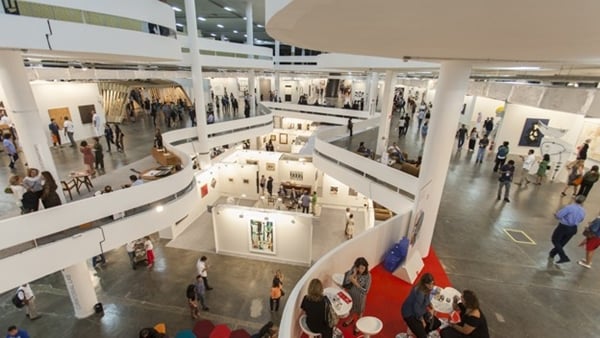
Wednesday’s VIP and press preview of SP-Arte drew a lively, engaged crowd, and it wasn’t just because of the ample complimentary Chandon champagne on offer. Visitors sipped as they strolled the sprawling the Biennial Pavilion—situated in Sao Paulo’s centrally located Parque Ibirapuera—and surveyed the vast array of offerings from new and established international galleries alike.
The debut of this year’s “Solo” section, curated by Inhotim contemporary art center director Rodrigo Mauro, was a standout. While it was perhaps not surprising that Brazilian artists were well represented here, it was also a pleasant revelation to see work by non-Brazilian galleries, and non–Brazilian artists who lived or spent time in Brazil and were inspired by its stunning natural beauty, or, on a more somber note, who observed and were willing to address the country’s history of social and economic problems in their work.
One standout booth was that of Paris gallery Esther Woerdehoff, who showcased the work of photographer Christian Cravo. Born in 1974 to a Danish mother and Brazilian father, Cravo spent the first six years of life in Salvador in the Bahia region of Brazil, returning there at age 17 to explore his connections to the country. The results include dramatic black-and-white shots of the less-traveled parts of the country’s northeast region. The gallery is also showing several of legendary Swiss photographer René Burri’s photos of 1960s Brazil, as well as Thierry Cohen’s vast, dark cityscape images of Sao Paulo (below), part of his Darkened Cities series, in which he superimposes skyline photos with images of the respective cities’ night skies without the light pollution that makes stars so difficult to see. There is perhaps no better example of a city in which to explore this notion than Sao Paulo, with a reported population of 20 million (and growing), and where the sea of high-rise buildings obscures any view of the horizon.
Thierry Cohen, São Paulo 23° 33’ 22’’ S 2011-06-05 lst 11:44 (2012).
Courtesy Galerie Esther Woerdehoff.
A stark take on Brazilian censorship in the 1970s is on view at the booth of Chilean gallerist Isabel Aninat, who is showing work by artist Voluspa Jarpa. The artist explores the Brazilian government’s near-ludicrous censorship of song lyrics in the 1970s with blown up reproductions of government documents in which the individual letters of each word are meticulously cut out by laser. The delicate, burned-looking edges of the absent characters create a haunting effect suggesting the aftermath of a violent event.
SALES
Elsewhere, the main section of the SP-Arte fair showcased high-profile Brazilian and international galleries alike, with works on offer ranging from Le Corbusier collages and Pablo Picasso drawings to blue chip Latin American names like Carlos Cruz-Diez and Jesús Rafael Soto, and on to YBA Damien Hirst and dynamic Brazilian street art twins Os Gêmeos. By the end of the preview day, several galleries confirmed major sales had been made.
Lucio Fontana, Concetto Spaziale, Attese (1968).
Courtesy Cardi Gallery, Milan.
Milan’s Cardi Gallery sold Lucio Fontana’s Concetto Spaziale, Attese (1968, above), a waterpaint on canvas. The gallery reports that the work had an asking price of €1 million. Also sold at their booth was Pino Pascali’s plastic and iron work Baco da setola (1968), which had an asking price of €180,000.
Sao Paulo’s Galeria Luisa Strina quickly found a home for Cildo Meireles’s Tic Tac Toe, made in part with wooden rulers, for $800,000.
Paris gallery Agnes Monplaisir was already seeing success with two shows of work by Olga de Amaral, in the Solo section as well as in the main fair. Her sculpture, Escrito X, sold for 1,160,000 Brazilian Real (about $510,000).
Kavi Gupta, of Chicago and Berlin, sold two works by Angel Otero, including SK-ML (Fence Series), an oil painting. Prices for the Otero works ranged from $25,000 to $45,000.
And Turin’s Galleria Franco Noero clocked sales including Red, Yellow, Blue, Black, Re-Stretch (2014) an oil on linen by Andrew Dadson (prices ranged from €10,000 to and €25,000).
Sao Paulo’s Galeria Leme sold Luiz Braga’s Homem na ilna dos a amores (2013) to Espirito Santo Bank, which will donate the work to the Pinacoteca do Estado de Sao Paulo museum. artnet News learned that the institution has also acquired, from Galeria Vermelho, an installation by Nicolas Robbio, Mar del Plata, Argentina (1975), priced at 22,000 Brazilian Real (about $9,670) and via donation. From Casa Triangulo, the institution acquired Vânia Mignone’s Sem título (Série Mulher) (2014).